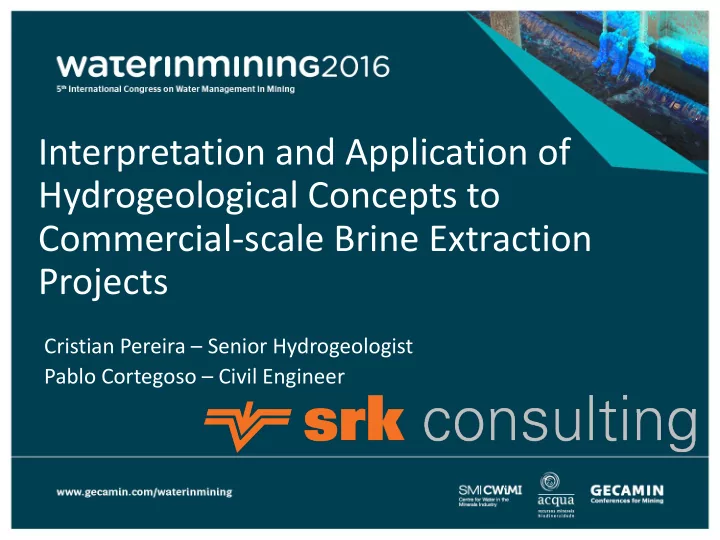

Interpretation and Application of Hydrogeological Concepts to Commercial-scale Brine Extraction Projects Cristian Pereira – Senior Hydrogeologist Pablo Cortegoso – Civil Engineer
Why brines? Why not??? Byproduct potential No miners Low surface impact No mining engineers Low OPEX Low environmental impact
Schematic Brine Deposit Source: A Preliminary Deposit Model for Lithium Brines. Bradley, D et al. USGS 2013
Intro to Brine Extraction Process Reagents Brine extraction from wellfield Water Power Process Plant Pre-concentration Ponds
Mineral Resource and Reserve Reporting For Brine Deposits Application of Hydrogeological Concepts
Increasing level of geological knowledge and confidence Modifying Factors: consideration of mining, processing, economics, marketing, legal, environmental, social and governmental factors
Brine Exploration Methods • Brine Samples • Hydraulic Conductivity Elemental analysis of brine samples Estimated from in-situ testing (e.g., packer collected from representative testing, short-term bore hole tests, pumping sampling depths tests) or ex-situ laboratory testing (e.g., ASTM) • Specific yield (Sy) or Specific storage (Ss) Approximated through in-situ testing (pumping tests) or ex-situ laboratory testing (e.g., RBRC - relative brine release capacity)
Matrix “Sampling” – In Situ
Brine Resource What is the challenge? • Dynamic Resource - Brine moves….. • Resource Volume - Aquifer volume and specific yield • Permeability governs rate of extraction • Once the pump is on; the system is ON! • Weather plays major role • Sampling storage • Spent brine disposal
Brine Resource: What are we looking for? • Brine Volume – Lateral boundaries – Vertical distribution – Specific Yield (Sy) or specific storage (Ss) for confined zones – Effective porosity (he) • Transmissivity, Hydraulic Conductivity (lateral and vertical) • Dispersivity (longitudinal and transversal) • Assays (Li, K, B, etc.) • Dilution (e.g. presence of fresh water, brackish, low grade)
Factors that matter: Extractability • In-situ recovery • Brine aquifer characteristics Characteristic porosity Specific yield Transmissivity Heterogeneity of stratigraphy Grade distribution
Initial brine elevation Volume of brine resource = Storage (Sy/Ss) x Volume of host aquifer
Production well Initial brine elevation Specific retention loss, S r Loss due to minimum well drawdown Brine elevation during Reserve base subject to an in-situ exploitation recovery factor
Numerical Groundwater Model for Brine Projects Numerical model is used for brine projects as “dynamic” resource model to support mineral reserve estimates. • Brine movement is a 3D process. • Numerical model combines geology, fresh water and brine flows, density driven flow, and optimal setting for production wells. • Fresh water intrusion and dilution effect must be considered (aquifers, rivers, precipitation events) Model predicts: • Extracted brine volume over time • Brine chemistry in time
Brine Concentration over Time Initial Conditions (0 years) 20 years of production 100 years of production
Numerical Groundwater Model for Brine Projects Quantity Quality
Take Home Message • Dynamic Resource • Hydrogeologist is the new “mine engineer” • Continuous update and calibration to the numerical dynamic model throughout the LoM
Recommend
More recommend